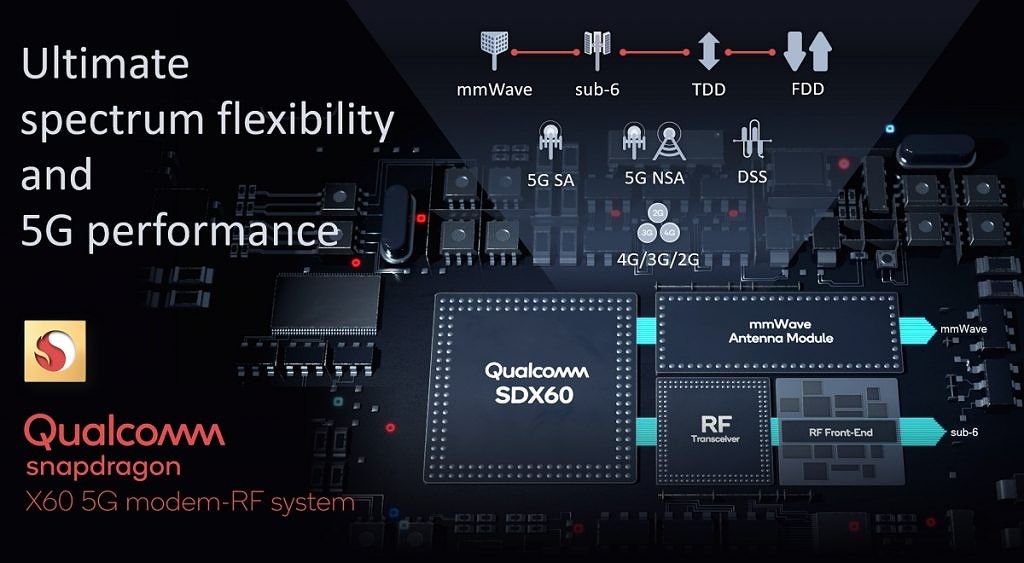Qualcomm has announced the Snapdragon X60 modem for flagship 5G phones. The news comes almost exactly a year after the announcement of its predecessor, the Snapdragon X55 modem. The Snapdragon X60 is the third-generation 5G modem-RF system from Qualcomm, succeeding the Snapdragon X55, which in turn succeeded the first-generation Snapdragon X50. The company has also announced the new ultraSAW RF filter technology. Let's take a look at both of these announcements one-by-one:
Snapdragon X60 modem-RF system
The Snapdragon X60 features the world's first 5nm baseband. (Qualcomm didn't state who will be manufacturing the X60, but given TSMC's leadership in the 5nm process, it's likely to be manufactured on TSMC's 5nm FinFET process.) The 5nm process will lead to power efficiency gains in a smaller footprint.
Update: Sources speaking to Reuters report that Samsung has won a contract to manufacture the new 5nm modem. The Reuters report states that Samsung will only be producing a portion of Snapdragon X60 modem chips and TSMC will also be involved in the manufacturing. It's unclear which company will manufacture the first batch of chips, however.
The Snapdragon X60 is also the world's first 5G modem-RF system to support spectrum aggregation across all key 5G bands and combinations, including millimeter wave (mmWave) and sub-6 (sub-6GHz 5G) using frequency division duplex (FDD) and time division duplex (TDD).
The system is engineered to accelerate network transition to 5G stand-alone mode through support for any key spectrum band, mode or combination. All 5G networks until now are using non-stand alone (NSA) mode, which means they require an LTE anchor for a 5G data link. 5G networks will soon transition to SA mode, however, which will allow them to be able to operate independently of LTE as the connection will be exclusively a 5G data link. The transition from NSA to SA will start in 2020 and continue in 2021.
The Snapdragon X60 features support for 5G Voice over NR (VoNR), which is the successor to VoLTE. It will allow users to make calls over 5G networks.
It also features the new Qualcomm QTM535 mmWave antenna module, which is the company's third-generation 5G mmWave antenna module, succeeding the QTM525 and QTM052 modules. This module has support for the 26/28/39GHz bands that are being/will be used in mmWave 5G networks in North America, South Korea, Japan, and Europe. As a quick reminder, 5G smartphones incorporating mmWave need at least two of these antenna modules, in addition to the modem itself. This is because mmWave requires a line-of-sight to the node to maintain connection, and its signal is so poor that it can be blocked by buildings, trees, and even a user's hand. It also doesn't work indoors. Therefore, device makers place these modules in different orientations (one will be placed on the top while the second will be placed on the left/right hand sides) of the phone so that it's not blocked by the user's hand. The QTM535 features a more compact design than the previous generation (Qualcomm didn't give specifics here), which will presumably lead to thinner phones.
The Snapdragon X60 allows for fiber-like Internet speeds and low latency, delivered wirelessly over 5G. Qualcomm hopes it will unlock the next generation of connected applications and experiences such as highly responsive multiplayer gaming, immersive 360-degree video and connected cloud computing. It will have "superior" power efficiency for "all-day battery life."
The major new feature of the Snapdragon X60 is that it's the world's first to support mmWave-sub-6 aggregation, which should allow carriers to maximise their spectrum resources to combine capacity and coverage. With this aggregation, carriers can have their peak throughput surpass 5.5Gbps, according to Qualcomm. It's also a way to have the best of both worlds as carriers can have both network coverage as well as capacity. Serious doubts remain on mmWave's ability to function as an effective 5G mechanism, though, because of the aforementioned limitations of the technology. The optimal use case for mmWave will probably be for outdoor public places such as landmarks, while sub-6 5G will function as the effective successor of 4G LTE.
It also features the world's first 5G FDD-TDD sub-6 carrier aggregation solution for double the speeds. This comes in addition to supporting 5G FDD-FDD and TDD-TDD carrier aggregation, along with dynamic spectrum sharing (DSS), which was introduced last year with the Snapdragon X55. DSS allows operators to deploy 5G services on low frequency FDD bands already in use for LTE, which is what T-Mobile is doing with its low-band "nationwide" 600MHz 5G network. The Snapdragon X60 gives carriers a wide range of deployment options such as being able to repurpose LTE spectrum for 5G to deliver higher average network speeds and accelerate 5G expansion.
Qualcomm says that with smartphones based on Snapdragon X60, operators can utilize a mix of frequency bands (mmWave, sub-6 GHz - including low bands), band types (5G FDD and TDD), and deployment modes (SA and NSA) to achieve an optimal combination of high-speed and low-latency network coverage.
The Snapdragon X60's theoretical maximum downlink goes up to 7.5Gbps, while the maximum uplink stays at 3Gbps. In comparison, the Snapdragon X55's theoretical maximum downlink is 7Gbps. Qualcomm says that the aggregation of sub-6GHz spectrum in SA mode allows the doubling of peak data rates in SA mode compared to solutions with no carrier aggregation support (i.e. the Snapdragon X55). Also, VoNR support will allow mobile operators to provide high-quality voice services on 5G NR.
In conclusion, Qualcomm says the Snapdragon X60 is the extension of a modem-to-antenna family that combines the baseband, transceiver, and complete RF-front-end for mmWave and sub-6GHz. The company is scheduled to ship samples of the Snapdragon X60 and QTM535 in the first quarter of 2020, with commercial premium phones using the new modem-RF system expected in early 2021. This means the modem-RF system will likely be paired with the next-generation Snapdragon flagship SoC, the Snapdragon 875. What we don't know yet is whether the Snapdragon 875 will integrate this 5G modem on-chip like the Snapdragon 765, or whether it will remain a discrete modem like the Snapdragon 865. This piece of information will be revealed in December at the annual Tech Summit. Another piece of unknown information is whether the Snapdragon 865 supports the X60 modem.
The 5nm process also means the Snapdragon X60 is unlikely to ship on products this year. In 2019, the 7nm Snapdragon X55 did manage to ship on two Snapdragon 855-powered products: the 5G AT&T and T-Mobile variants of the Samsung Galaxy Note 10+ as well as the T-Mobile OnePlus 7T Pro 5G McLaren.
ultraSAW RF filter technology
Along with the Snapdragon X60, Qualcomm has also announced its ultraSAW RF filter technology. This is said to be another "groundbreaking innovation". It's said to significantly improve radio frequency performance in bands up to 2.7GHz, and it's also said to outperform competing filter technologies at lower cost.
Radio frequency (RF) signals isolate radio signals from the different spectrum bands that phones use to receive and transmit information. According to Qualcomm, its ultraSAW filters achieve as much as 1 decibel (db) improvement in insertion loss, thereby offering a higher performance solution compared to competing bulk-acoustic (BAW) filters in the sub-2.7GHz frequency range.
Qualcomm's ultraSAW technology is said to achieve superior filter characteristics to deliver high performance in frequencies from 600MHz to 2.7GHz with benefits including excellent transmit, receive and cross isolation; high frequency selectivity; a Q-factor of up to 5,000 - which Qualcomm says is significantly higher than the quality factor of competing BAW filters; very low insertion low; and excellent temperature stability with very low temperature drift in the single-digit ppm/Kelvin range. According to the company, all of this allows for more-efficient RF paths in 5G and 4G multi-mode devices at a lower cost point than competing commercial solutions with similar performance metrics for OEMs.
The ultraSAW technology serves as a key one behind the performance of Qualcomm's radio frequency front-end (RFFE) product portfolio (which is under scrutiny by the European Commission) as well as its 5G modem-RF systems. The company is integrating this technology across its product line including PA modules, front-end modules, diversity modules, Wi-Fi extractors, GNSS extractors, and RF multipliers.
For consumers, Qualcomm says that improved RF performance will help device makers bring 5G devices with superior connectivity and battery life to consumers. A lineup of discrete and integrated Qualcomm ultraSAW products will begin production this quarter. Flagship devices from device makers are expected to be commercially available in the second half of 2020.


